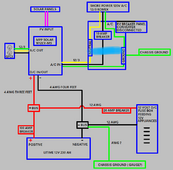BobShrunkle
New Member
So I have my system up and running in my camper and I'm wondering if I can get the GFCI outlet to work with how my setup is configured.
My all-in-one inverter is the MPP PIP1012LV-MS.
The GFCI measures 120v hot to neutral, 120v hot to ground and 0v neutral to ground. Circuit tester shows correct wiring at GFCI outlet.
So based on those 4 measurements I'm WAS assuming the inverter is bonded when off grid.
However the GFCI does not trip when tested from itself or from my circuit tester.
What am I missing?
My all-in-one inverter is the MPP PIP1012LV-MS.
The GFCI measures 120v hot to neutral, 120v hot to ground and 0v neutral to ground. Circuit tester shows correct wiring at GFCI outlet.
So based on those 4 measurements I'm WAS assuming the inverter is bonded when off grid.
However the GFCI does not trip when tested from itself or from my circuit tester.
What am I missing?
Last edited:




